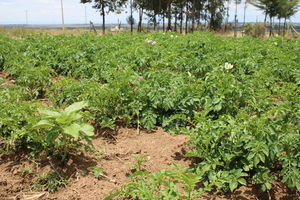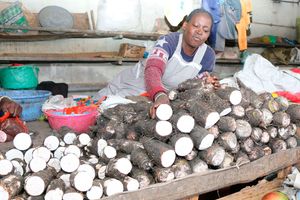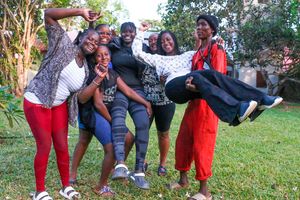Breaking News: Former Lugari MP Cyrus Jirongo dies in a road crash
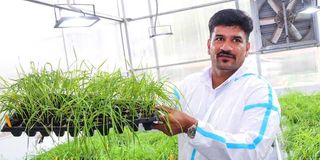
Sridhar Bhavani, the Principal Scientist and Wheat Improvement Lead for Africa at the International Maize and Wheat Improvement Centre, in the rust-screening facility at Kalro, Njoro on April 5, 2025.
Wheat is the third most important cereal in the world after rice and maize.
It is the largest cultivated cereal on Earth, at 240 million hectares and more than 780 million tonnes a year. Wheat is also the largest traded commodity on the planet, with a value of $60 billion annually.
Africa produces around 25 million tonnes of wheat on 10 million hectares annually. The cereal is mostly grown in the northeast, east, southern and parts of West Africa.
Feasibility and economic viability studies by the International Maize and Wheat Improvement Centre (CIMMYT) and the International Food Policy Research Institute (IFPRI) show that wheat can be grown on more than 25 million hectares in 25 African countries.
Dr Sridhar Bhavani, the Principal Scientist – Wheat Improvement Lead for Africa at the CIMMYT – says production in Kenya is on 150,000 to 200,000 hectares.
Wheat is primarily grown in Narok, Nakuru, Uasin Gishu, Trans Nzoia and Laikipia counties, with Narok being the leading producer.
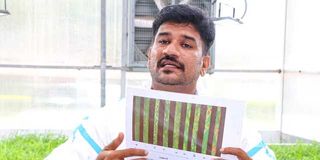
Sridhar Bhavani, the Principal Scientist and Wheat Improvement Lead for Africa at the International Maize and Wheat Improvement Centre, in the rust-screening facility at Kalro, Njoro on April 5, 2025.
Kenya produced 309,492 tonnes on 104,440 hectares in 2023. The total wheat consumption, including imports, was 2.2 million tonnes in the same period.
The country imported 1.99 million tonnes valued at $654 million in 2023.
Kenya roughly produces just 14 percent of wheat consumed locally, with the rest imported. Increasing land under wheat will reduce imports greatly, the CIMMYT says.
Dr Bhavani says despite some milestones, fungal diseases like yellow and stem rust continue to cause havoc in eastern Africa, Kenya included.
Yellow rust and stem rust cause significant production losses. Experts say yellow rust can reduce yields by up to 60 percent while stem rust can wipe out the entire crop.
“Yellow rust is the most damaging disease on wheat worldwide,” Dr Bhavani says. “The disease mostly affects the leaves, reducing the photosynthetic area, unlike stem rust which affects all parts above the ground, including leaves, stems, awns and glumes.”
He says the biggest damage occurs when the disease disrupts the movement of water and nutrients from the lower parts of the stem to the spikes where the grain filling gets affected, resulting in shrivelled seeds and reduced chaff.
Dr Bhavani says stem rust is one of the most feared diseases worldwide, while the biggest challenge with farmers is understanding the symptoms and scouting them early to monitor progress.
It is important to understand that these rust pathogens evolve rapidly, defeating the resistance genes in the varieties and making them susceptible after several years.
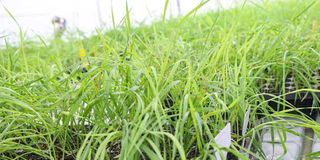
Wheat in Rust Research Facility at Kenya Agricultural and Livestock Research Organization (KALRO) Njoro, Nakuru County, on April 5, 2025.
Breeding pipelines
Breeding improved varieties are, therefore, important.
This is done by CIMMYT and the Kenya Agricultural and Livestock Research Organisation (Kalro), helping to stay ahead of the disease.
Dr Zennah Kosgei, the Plant Pathologist at Kalro in Njoro, says characteristics of stem rust include small to medium-sized, orange pustules on the stem.
The pustules may not be as large on leaves as those on the stem, but they often appear in clusters on the upper and lower surfaces of the leaf.
She says other emerging diseases the researchers are looking out for are spot blotch and fusarium head blight – affecting the wheat heads. It is exacerbated by climate change.
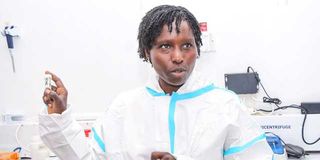
Zennah Kosgei, a plant pathologist, at the Kenya Agricultural and Livestock Research Organisation on April 5.
@DNation Caption:RICHARD MAOSI | NATION
Nakuru County, which hosts the research centre, produces a significant amount of wheat a year.
It is the second-largest wheat-producing county in Kenya. The crop is grown in Njoro, Rongai, Molo, Bahati, Kuresoi North and Naivasha.
Kalro uses ICT applications to reach smallholder farmers. The aim is to ensure the information, products and management strategies on pests and disease reach wheat farmers on time.
Understanding that Kenya was a hotspot, CIMMYT and Kalro established a quarantined stem rust phenotyping platform in 2008.
Since then, more than 700,000 wheat accessions from 25 countries have been tested at the station, resulting in the release of at least 240 varieties in several countries even before the disease moved out of Africa.
Dr Kosgei says CIMMYT expanded operations by shuttling materials from Mexico to Kenya and Kenya to Mexico, helping to breed resistant varieties to be deployed in East Africa and other countries.
Dr Bhavani says Kalro-Njoro has been recognised as a global hub for stem rust testing, benefiting wheat producers and consumers around the world, including the US, Canada, the UK, Europe, Australia and Asia.
The CIMMYT-Kalro partnership received a Borlaug Global Rust Initiative-Gene Stewardship Award in 2015.
The partnership trains hundreds of researchers, with more than 15 courses offered every year.
In 2022, CIMMYT decentralised one of the breeding pipelines for Africa to be established in Kenya. It is the first joint breeding programme between CIMMYT and Kalro.
CIMMYT has invested in the Crops to End Hunger programme that is funded by GIZ, Germany, ensuring the building of the rust research centre.
The station has equipment, including a quantum plot combine, planters, threshers, tractors, field equipment, cold stores, seed processors and a reservoir for irrigation.
Some $350,000 was invested in building a modern greenhouse. The quantum plot combine is estimated to be valued at $250,000 while the planters, tractors, irrigation kits and other equipment are valued at $1.5 million.
Research at the station speeds up breeding for rust resistance, enabling scientists to identify new rust races that can help introduce effective resistance genes.
“The phenotyping platform supports the breeding activities and the equipment enhance precision during planting and harvesting, resulting in the accuracy of field trials and data,” Dr Bhavani says.
He adds that despite releasing more than 30 varieties in 20 years, access for recent varieties by smallholder farmers is a challenge.
Producing and distributing adequate amounts of certified seeds to farmers is also another problem the station faces.
The centre is calling for strong policies supporting wheat production that target self-sufficiency, including subsidised inputs, smallholder machinery, improved agronomy and premium market prices for grain.
It says giving credit to smallholders can result in a huge expansion as witnessed in Ethiopia. Investments by the African Development Bank, other financial institutions and donors can have an impact.
Kalro Njoro Centre Director, James Karanja, says the station applies advanced technology to mimic the exact conditions of the crop in the field.
The goal is to speed up the development of new wheat varieties that are resistant to rust.
“Traditionally, developing a resistant wheat variety has been lengthy, taking seven to eight years. This new centre offers ways we can develop the varieties to just four to five years,” Dr Karanja says.

